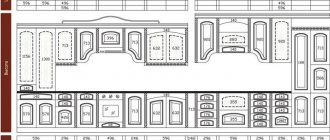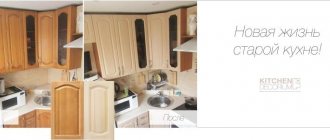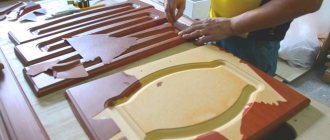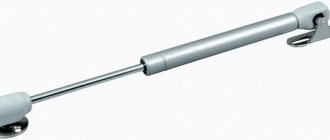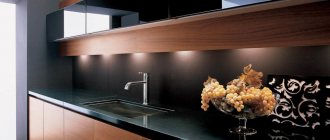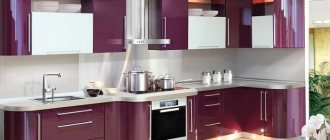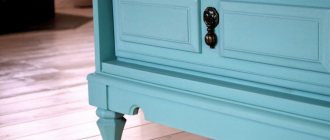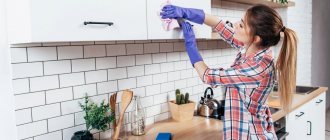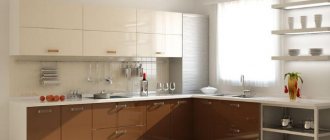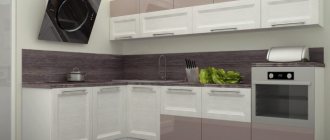The kitchen set in the house is the pride of the owners; enormous attention is paid to its design and selection, and this is no coincidence, because the appearance of the house as a whole depends on how functional and beautiful it is. In our article we will tell you how to apply patina to MDF facades so that the kitchen sparkles with new colors. Patination (covering with patina) the facade of a furniture set is at the height of fashion; a kitchen with such furnishings will win the hearts of your guests.
From our article you will learn how to do this work yourself in 7 steps so that your house looks flawless, stylish and aristocratic.
Not only MDF facades can be patinated, but also veneered facades and those covered with PVC film. To do this, you will need to stock up on some building materials (we will tell you about them below), patience and arm yourself with the knowledge that you will learn in our article.
How to make patina on facades made of MDF and PVC film?
Is it possible to make a patina on white kitchen facades from MDF and PVC film if you want to get the effect of an aged antique marble look?
First, let me clarify that making a patina means creating an artificial aging effect on the facades so that they look old, “antique.” Previously, this method was only available for metal surfaces, but today even on MDF facades with PVC film you can create such a miracle. I will say right away that it is best to buy ready-made facades with an aging effect, because the patination process is quite complex, akin to a serious form of art.
For patting you will need: guns, a compressor, air preparation and a spray booth.
The patting process goes something like this: if the facades are new, then they can be degreased and a layer of primer can be immediately applied. If there is dirt on the facades, they are removed with alcohol and only then primer is applied. The primer dries, the facade is thoroughly cleaned, completely sanded using hard sandpaper, and after that we apply a layer of white enamel. It takes a day or more for the facades to dry. When the facades are completely dry, you need to apply a patina to them by spraying. After this, the patina is rubbed off with sandpaper (fine), aluminum or any metal wool of medium hardness, rags or Scotch Brite. The remains are blown off and the facades are covered with colorless varnish.
Source
How masterpieces are created
Patina is the name given to a natural phenomenon. Under its influence, changes in wood and metal occurred in natural conditions. It was first noticed when studying coins made of copper, silver or gold.
- Time in tandem with the environment contributed to the appearance of deposits on the surface of certain objects. It changed their original appearance: the brightness of the paint changed, darkening appeared, and minor cracks were clearly visible.
- The cost of items with such coating was quite high. If you carefully examine objects classified as antique, you can admire the natural patina even with the naked eye.
- Furniture made from expensive solid wood ages very gracefully, which explains the desire of art connoisseurs to purchase it as their own. However, the cost of antiques is so high that not everyone can afford to buy them.
- To meet the needs of ordinary people, a technology has been developed that allows the production of patinated facades using solid MDF. It came to be called patination. As a result, almost anyone today can purchase furniture that shows signs of noble aging, but at a very affordable price.
This technique makes it possible to achieve the effect of antiquity on almost any surface. It can be either laminated MDF or paint-coated solid wood.
Patination technology for MDF facades
The technology of patination of MDF facades is used extremely rarely by furniture companies.
Why? Because a high-quality patinated MDF facade in PVC film is quite difficult to distinguish from products made of natural wood, which most often use aging effects. Unlike processing MDF, working with solid wood is much more difficult and time-consuming. Therefore, most entrepreneurs bypass such technologies, trying to make their product cheaper. However, unlike others, the technology for patination of MDF facades is not so complex that it should be abandoned. You just need to know the general principles of the patination technique, and mastery will come with experience. The money spent will pay off in the sale of truly truly exclusive furniture.
Patination of MDF facades is the treatment of the facade coating in order to give it the effect of an aged natural or artificial material and highlight the surface texture with special paints (patina).
The process of patination of an MDF facade in PVC film consists of the following stages:
1. A special adhesive barrier primer is applied in a thin layer to the surface of the previously thoroughly cleaned MDF facade. To achieve the best quality, the primer is applied using a spray gun.
2. The second layer is applied with colorless polyurethane primer for patina.
3. The primed surface is polished.
4. A patination compound is applied. Patina or patination compositions are special paints and varnishes with special properties, used to visualize the aging of a facade or create decorative color effects on it.
The most popular patination techniques for MDF facades are the classical method, contrast patination and the crackle technique.
The first patination method is used to age MDF facades with complex milling of wood-look PVC film-coated facades. It would be good if the texture of the film is covered with depressions that imitate wood fibers. Patination of the MDF facade is done with a paint color slightly darker or lighter than the main background. After the patina layer has dried, they begin to sand the surface using a regular sponge made of fishing line. The achieved effect is secured, as a rule, using a glossy patina varnish, which will emphasize the depth and highlight the aging elements of the facade.
Contrasting patination is used to highlight specific areas of the milled design. Most often, patination compounds in gold, silver, copper or other colors are used for this. The patina is applied in an even layer to the primed surface of the milled recesses using foam rubber or a brush. Excess is carefully removed. After drying, a second layer is applied, which gives an aging effect and imitates joints on the surface of the facade. To fix gold and silver paints, it is recommended to use a matte varnish, since a glossy sheen will obscure the resulting effect.
The “crackle” technique is aimed at achieving the effect of cracking the old layer of paint or varnish on the surface of an MDF facade. To do this, two layers of special craquelure varnish are applied to the MDF facade. The second layer is applied after the first one has dried “to touch”, after about half an hour. It should be remembered that the depth and size of the cracks will depend on the thickness of the varnish layer. After the varnish has completely dried, the cracks are filled with a contrasting patina or special grouts of gold, silver or any other suitable shade different from the main background. Excess is removed with a sponge. Next, the resulting effect is fixed with a layer of varnish.
who brings gifts to the field of miracles
Patina varnish using the craquelure technique is applied either by spraying or using a swab or brush. At the same time, various patterns and cracking effects can be obtained on different parts of the façade surface.
The technology for patination of MDF facades does not stand still and is constantly evolving, using a variety of methods and aging techniques. Today, the effects of leather, pearls, drops, metal grain, magnetic fields, marbling, corduroy, wormholes, mother-of-pearl and others are used on furniture facades. Some of them can perfectly match one or another style of furniture produced by the company.
Source
Mechanical resistance
The indicator is quite low for facades covered with film: traces are easily left, for example, from a cut with a knife. Also, do not expose the surface to aggressive cleaning agents, such as powder.
Patinated facades withstand mechanical stress well. With strong pressure, a mark may remain that will not be noticeable on a surface of a certain texture. Patinated furniture is also resistant to abrasion.
Veneered facades are resistant to mechanical stress. Even cuts leave virtually no traces behind.
Patination of furniture is a special way of applying paint in certain places to create decorative effects. Thanks to this approach, the facade looks more elegant and resembles antiques. At the same time, the furniture itself can be made from budget materials, which will not be noticeable in any way. Painting compositions can be applied to the MDF film facade or natural solid wood.
Patination is carried out using several methods - manual application with a brush and spraying with a spray gun. Both of them have their advantages and disadvantages, so using them together is the most successful, especially if complex effects are required.
Contents of the technological process of patination of MDF facades in PVC film
Preparing the surface for applying patina
The room where painting is carried out must be provided with an air temperature of 18-25 C depending on the time of year and a relative humidity of 45-70%.
Wet cleaning of floors should be done at least once per shift to reduce the possibility of contamination of the surface of the coatings being formed. The temperature on the surface of the parts and the temperature of the material must be at least 18 C.
The surface of the parts is thoroughly blown with an air gun and degreased. The entire facade surface is wiped with a rag moistened with acetone, especially carefully along the profile.
The degreasing operation is important and determines the degree of adhesion of the patina and varnish to the surface of the film, because PVC film is essentially plastic with low adhesion to any finishing materials.
Applying patina
The patina must be thoroughly shaken before pouring into the spray tank so that it is in suspension. To apply the patina, a pneumatic spray gun with a nozzle diameter of 1.5-1.8 mm and a pressure of 2 atm is used. with a narrow flame and low flow rate.
Patina on solvents and water. The nuances of diluting, applying and removing excess patina.
When applying patina along the contour and internal profile, avoid excessive application of patina. The coating should be uniform, without transitions. The degree of patination is determined visually in accordance with standard samples. Excessive application of patina worsens the degree of its adhesion and the subsequent finishing layer to the PVC film.
| Rice. 1. Applying gold patina |
Excess patina that extends beyond the contour is removed after drying using steel wool and acetone. The drying time for the patina in the drying chamber is 20-30 minutes.
| Rice. 2. Removing excess patina using metal wool |
Description
Patination of wood is its artificial aging by applying two layers of paint alternately in a certain way, but let's talk about everything in more detail:
Stage No. 1: preparation of materials and tools
Gold patina paint for wood
You will need the following materials:
| Name | Purpose |
| Primer | Increases the adhesive properties of the treated surface |
| Dye | Creates the first solid layer of the finish in question, for which you can use any color, in this case you should be guided by your own preferences, practicality and compliance with the surrounding interior |
| Patina | The second is applied selectively, giving that very necessary scuffed effect; metallic shades of bronze or gold are best suited for this task. |
| Varnish | Creates a transparent protective coating |
Watch a video of patination of MDF facades in P VX film:
Applying varnish
Before applying varnish, the surface of the facade must be blown to remove patina particles remaining on the surface after using steel wool.
Prepare a working solution of varnish in the proportion of 100 parts by volume of OP383 varnish and 50 parts of hardener C376A. To bring it to working viscosity, add 10 parts by volume of solvent D1010. Viability of the working mixture is 5-6 hours at a temperature of 20 C. Viscosity of the working varnish solution is 20-22 sec. The diameter of the spray gun nozzle is 1.8-2 mm, the pressure is 3.5 atm. Varnish consumption per layer is 120-150 g/m. sq.
The varnish is applied in a spray booth with a water curtain. The varnish is applied in one layer over the entire surface and edges without gaps. Avoid excessive application of varnish, which may cause subsequent peeling of the varnish from the PVC film.
The distance from the nozzle to the surface to be treated is 200mm and reaches 300mm. A greater distance of the nozzle from the surface to be painted can cause shagreen and bubbles on the surface of the part to be finished.
| Rice. 3. The facade with patina is varnished |
Parts are dried in a drying chamber on stacked racks at a temperature not lower than 20 C. Dry from dust 15 minutes after applying the varnish, to the touch after 45 minutes, completely dry no earlier than after 4 hours, ready for packaging after 12 hours.
To increase the degree of adhesion of the varnish to the film, it is possible to add special additives, which requires checking their effectiveness.
Sphinx sauna on Sampsonievsky
Applying patina to facades in film, Italian technology
Possibility of repair
Defects that appear on the film cannot be restored or painted over - the entire coating will have to be replaced.
The facade in the style of antique furniture very rarely requires repair. Not only is it resistant to many factors, but the consequences of impacts such as a cut are almost invisible. If the defect is noticeable, it will be quite easy for the technician to correct it, provided that the damage has not gone deep into the film.
Veneer facades are easy to repair. For minor damage, sanding can be used. For more extensive ones, a patch is used. As a last resort, you can dismantle the panel and replace it with a new one.
Patination defects and causes of their occurrence
Only single bubbles, craters with a diameter of no more than 1 mm, punctures, mechanical inclusions with a size of no more than 1 mm, scratches, and two noticeable shagreens are allowed on facade surfaces.
The total number of simultaneously present defects listed above per 0.5 sq. m. surfaces from among the permissible (quantitatively assessed) - no more than 2 pieces.
The main defects in patina finishing and their causes are presented in Table 2.
Main patination defects and their causes
| Coating defect | Possible reason |
| 1. Uneven application of patina | Poor preparation of the base, incorrect application technique, inappropriate type and parameters of the spray gun |
| 2. Peeling and poor adhesion of patina and varnish | Poor preparation of the base, incompatibility of materials, excessive application of patina and varnish |
| 3. Varnish smudges | Incorrect application process, inappropriate nozzle diameter, low paint viscosity, wrong thinner |
| 4. Uneven application of varnish | Unskilled application technique, poor preparation of the base. |
LiveInternetLiveInternet
–Categories
- (0)
- +++Hobbies (3604)
- PERGAMANO (1)
- costume jewelry (92)
- Beads (64)
- rope (22)
- embroidery (2)
- Crochet (317)
- Knitting needles (333)
- newspapers. straws (40)
- Clay Porcelain Gypsum (67)
- Decoupage (1249)
- jute (46)
- cardboard (12)
- kinusaig (1)
- Rugs (61)
- Beauty from nothing (137)
- macrame (28)
- New Year's (189)
- origami paper quilling (72)
- papier-mâché (44)
- Easter (61)
- PLASTIC dishes (65)
- patchwork (1)
- Miscellaneous (218)
- christmas (10)
- scrapbooking (1)
- soutache filigree (16)
- spot painting (315)
- foil (1)
- TATTING (3)
- Sewing beauty (162)
- joke (12)
- boho (30)
- VERA (14)
- hair (19)
- education (38)
- games (14)
- presentations (1)
- psychology (2)
- geography (44)
- House 6)
- painting (918)
- animals (108)
- LAW (3)
- Health (91)
- diet (1)
- charging (17)
- leather (22)
- herbs (6)
- interesting (19)
- interior (71)
- curtains (10)
- Art (13)
- cinema (21)
- books (93)
- computer (39)
- Cooking (1231)
- sandwiches (5)
- second (151)
- baked goods (154)
- desserts (84)
- Jewish (2)
- blanks (126)
- Snacks (87)
- candy chef (122)
- multicooker (7)
- meat (74)
- drinks (17)
- fish (35)
- salads (85)
- sauce (43)
- Liquor (8)
- soups (29)
- cheeses (19)
- phyllo dough (2)
- cakes pastries (134)
- medicines (1)
- lyrics (31)
- makeup (1)
- mathematics (5)
- prayers (10)
- music (145)
- soap making (3)
- nails (3)
- politics (157)
- parable (17)
- draw (94)
- Russian language (23)
- Gardening (215)
- Samodelkin (187)
- repair (12)
- funny (54)
- tips for housewives (187)
- fashion (20)
- tables (7)
- dancing (8)
- dish decoration (39)
- flowers on the window (48)
- quotes (56)
- sewing (354)
- alterations (90)
- bags (23)
- SLIPPERS (3)
- sewing machine (1)
- SCHOOL (4)
- Esoterics (29)
- etiquette (22)
- lawyer (9)
Patinated MDF facades. Patination technology.
The technology for manufacturing patinated MDF facades is complex and exclusive only at first glance. In fact, it is not difficult at all. The only thing is the technological process of patination of MDF
requires a certain amount of time and well-practiced skills of the master. But experience is easy to gain in the process of work, you only need general knowledge of the very principle and process of manufacturing patinated MDF facades.
You can write a lot about the advantages and disadvantages of patinated MDF, so I won’t do that. Everyone will decide this question for themselves, based on their preferences. It’s better to talk about the production technology of these very patinated facades, i.e. facades with an artificial aging effect applied.
In this article I will make an attempt to reveal and popularly describe all the details of how MDF is patinated
.
Peeling off
Film facades are quite sensitive to the atmosphere - they can peel off under the influence of excess humidity and elevated temperature.
The varnish, with the help of which the aging effect is created, becomes an obstacle to any negative factors, be it moisture or heated objects. This prevents the film from peeling off and deformation of the product. But at the same time, you should carefully consider the back side of the facade, since it is not subject to varnish treatment. Therefore, you should not exert any mechanical, temperature or other influences on the inner surface, otherwise no film or varnish will be able to save it from deformation.
Veneered facades are quite reliable, but incorrect pasting, faulty production technology or low quality materials can lead to rapid peeling.
MDF patination technology.
Basis for a patinated façade.
The base is prepared using the usual technology for manufacturing conventional film MDF facades. Let me briefly remind you of the technology for manufacturing MDF film facades.
Ready-made conventional film MDF facades.
| Facades with simple milling. | With complex milling. | |
At the end of this usual process, the MDF facades are sent for patination.
The process of patination of furniture MDF facades.
1. Applying an insulator.
Using a spray gun,
a layer of adhesive barrier-soil (insulator) is applied to the surface of the MDF facade.
This should be a special barrier primer for laminated surfaces. Apply a very thin layer. Example: Two-component polyurethane adhesive barrier primer for laminated paper TR 5008 from Sayerlack. Used to provide adhesion to melamine paper and other difficult-to-paint surfaces.
2. Second layer of polyurethane primer.
For this layer it is recommended to use a colorless polyurethane primer.
Example: colorless primer for MDF TU100 from Sayerlack. This primer dries quickly and can be sanded within half an hour.
3. Fine grinding
second layer of soil.
5. Patina treatment.
Patina is processed in various ways, which depend on what kind of effect you want to achieve. This could be a sponge made of metal shavings or fishing line, scrapers, or a piece of foam rubber.
We will dwell on these technological stages (4 and 5) a little lower.
6. Varnishing.
After all, the created effect must be secured and protected from external influences. To do this, use glossy or matte polyurethane varnish.
Of course, the Sayerlack coatings presented as an example are not at all fundamental. For patination of MDF
You can use LKM and other manufacturers with similar parameters. At the same time, the use of polyurethane primers and varnishes is also not necessary. For these purposes, everyone can choose their own set of paints and varnishes, which for objective reasons is more convenient or accessible to them. It is also quite possible to use acrylic-based paints and varnishes.
List of some companies producing varnishes and patination compounds:
Applying patina. Patination effects.
It is not the concern of this article to describe all the techniques for applying patina. Here I will just try to describe a couple of the most commonly used methods of how to patina MDF
.
Method 1.
Simplest.
A layer of patina is applied to the prepared façade, lined with a wood-like textured film, which, after drying, is sanded with an ordinary washcloth (kitchen mesh) made from metal shavings or fishing line.
You can use sandpaper, but its use requires high skill. The more intense the grinding, the more pronounced the aging effect. The color of the patina can be selected experimentally. For a simple effect of old varnish or wood, it is better to use a patina that is quite a bit darker or lighter in tone than the background. The most suitable for this method are MDF facades with complex milling and lined with wood-like PVC films with a texture that imitates the pores of natural wood (i.e., micro-indentations in the texture of the film). With this patination method, it is better to use glossy varnishes, which will emphasize and highlight the effect and give it depth.
Method 2.
Contrasting patination.
Method 3.
The “crackle” effect or the technology of creating craquelure on a varnish surface.
Crackle technique with patina grout
.
Apply the first layer of craquelure varnish, after about half an hour, when the layer dries “touch”, apply the second layer. The depth and effectiveness of cracks depends on the thickness of the layers. To speed up the drying of the second layer and for faster formation of cracks, drying can be done using a hair dryer. After the varnish has dried and cracks have formed, rub a contrasting grout into them (gold or aluminum powder, patina of much darker or lighter tones than the background), removing excess. Craquelure varnish is not strong, and the cracks are quite fragile, so the entire effect must be secured with a surface layer of varnish. You can first cover the façade with the applied craquelures with a general layer of patina (as in method No. 1), or you can immediately apply a finishing layer of varnish. But it is preferable to apply the finish after general patination on top of the craquelure. Craquelure varnishes
are applied by spray, brush or swab. By spraying varnish, the entire surface is covered with craquelure, while precise application with a brush or swabs allows you to create more complex effects, highlighting specific areas of the facade. Several layers of varnish can be applied in sections, for example, covering the entire facade with a thin layer, and applying additional layers only in the corners. This will create a more realistic effect of uneven cracks.
These were the main patination methods
.
There are a great variety of all methods, and their nuances are even greater. There are corduroy, pearl, marbling effects, metal grain effects, wormholes, magnetic, leather effects, mother of pearl, drops and many others. All information about these effects can be found on the Internet, especially where decoupage techniques
.
In each specific case, for a specific production, it is worth choosing your own, “branded” series of patinated MDF facades
, and for this, work out and take, so to speak, to the masses, a couple of different effects, applying them with facades of various millings and colors.
To write the article, four photographs of MDF facades, openly published on the Internet, were used.
Source
Popularity of aged furniture
Whatever one may say, everything new is well forgotten old. From time to time, things that look similar to those once used by our great-grandmothers come back into fashion. Moreover, despite the apparent antiquity, they look very stylish and organic. This also applies to furniture, and not just clothes or souvenirs, equipment or a number of other items. Moreover, it is not necessary to use exactly old things - in some cases they can be completely new, just artificially aged.
Patina and its types
Stain is often used to restore furniture
The effect of artificial aging can be achieved using a number of simple techniques. For this purpose, various chemicals, as well as mechanical or thermal methods can be used. Artificial aging is a technology of antique imitation . Moreover, it is possible to decorate not only furniture in this way, but also doors or windows, etc. Nowadays, aged furniture is considered quite prestigious and beautiful, it seems very reliable and often, contrary to the opinion that a person simply does not have the money to buy a new one, can be considered luxury item.
Classic white kitchen with gilding
Table. Methods for aging furniture.
| Methodology | Description |
| Chemical | This is the best way to age wooden furniture. Moreover, this is the easiest option that can be implemented at home. As a rule, it is simply enough to treat the furniture with some kind of chemical (for example, ammonia, if we are talking about hardwood) and that’s it. With coniferous facades you will have to tinker a little. However, the chemical method in any case involves the use of various chemical compounds, including paint. This technique also includes the so-called patination. |
| Mechanical | This option is suitable if you want to realize the effect that insects create during their life. That is, furniture treated in this way will appear to be eaten away by them. To do this, you will need to use an awl and nails, and use them to make small paths or depressions. The main thing is not to forget to clean the damaged surface from the resulting debris and cover it with a protective agent. |
| Thermal | This option is also quite simple and consists in burning out a number of elements using the same soldering iron or special devices. Its natural pattern will appear on the tree. It is enough to remove the accumulated carbon deposits with a brush and cover the surface with stain, and the furniture will turn into a real rarity. |
An impressive duet of craquelure and patina
Dear "Mr. Chest of Drawers"
On a note! The easiest way to artificially age objects made of wood is when it comes to doing it yourself.
Classic aging with acrylic paints
